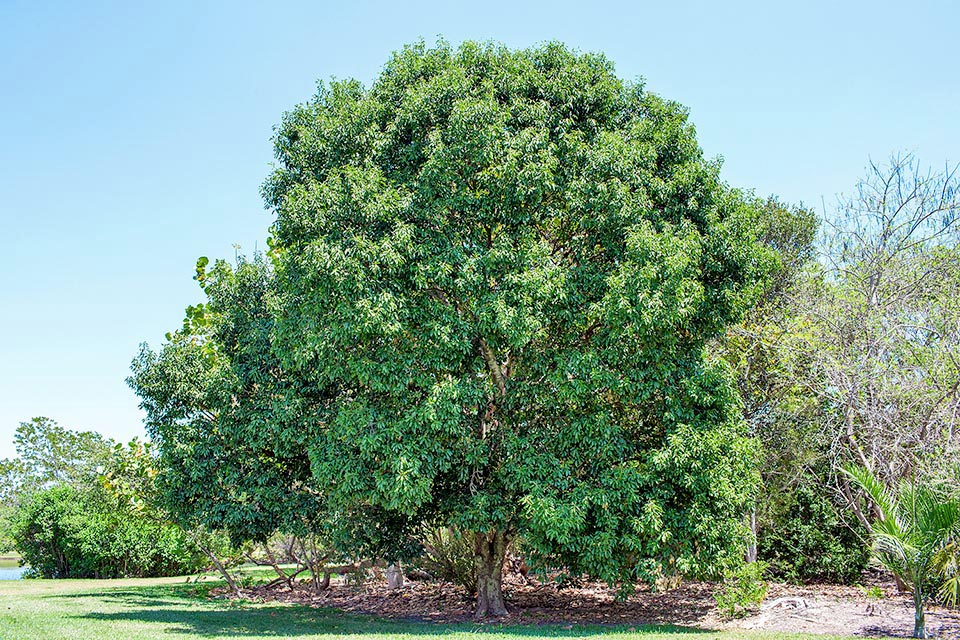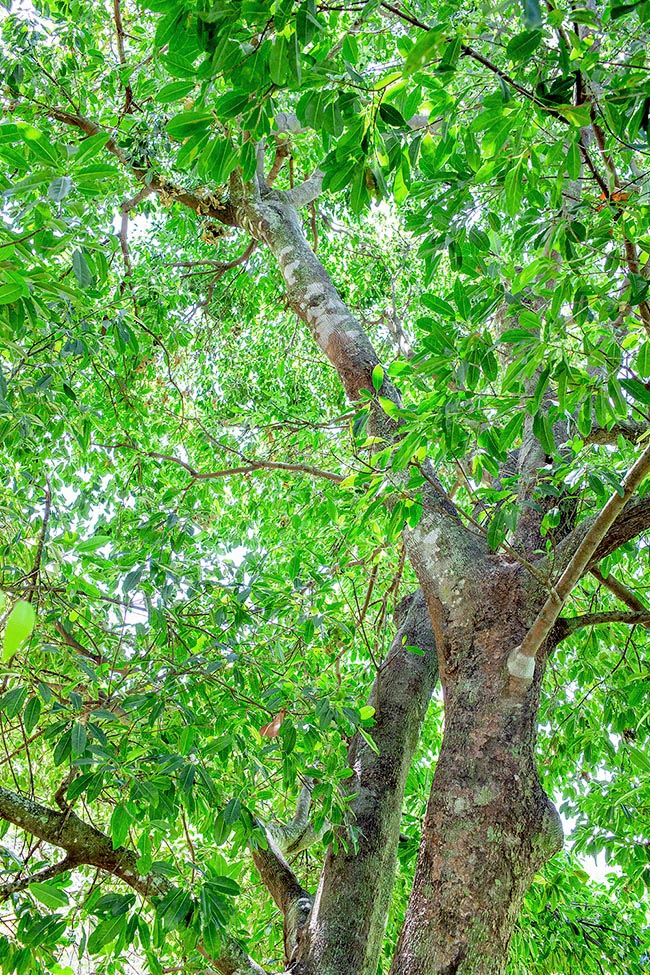Family : Sapotaceae

Text © Pietro Puccio

English translation by Mario Beltramini
The species is native to Antigua and Barbuda, Bahamas, Barbados, Belize, Cayman Islands, Cuba, Dominica, Guadeloupe, Guatemala, Hispaniola, Jamaica, Martinique, Messico (Campeche and Quintana Roo), Puerto Rico, Trinidad e Tobago, U.S.A. (Florida) and Virgin Islands where it grows on sandy soils or calcareous rocks covered by a layer of organic soil, from the sea level up to about 600 m of altitude.
The name of the genus is the combination of the Greek substantives “σίδηρος” (sideros) = iron and “ξύλον” (xylon) = wood; the name of the species is the superlative “foetidissimus, a, um” of the Latin adjective “foetidus, a, um” = foetid, smelly, with reference to the smell emanated by the flowers.
Common names: Barbados mastic, cayman brac, false mastic, mast wood, mastic, mastic bully, mastic jungle plum, wild olive (English); akoma, koma (Creolé); acoma, acoma bâtard, acoma saint Christophe, acomas, acomat, acomat franc, acomat franc-tête de mort, bois d’accomma, bois de fer, bois de fer blanc, bois de fer des Antilles (French); carocolillo, caya, caya amarilla, ebano amarillo, jocuma, jocuma amarilla, subul, tabloncillo, tocuma amarillo, tortugo amarillo, tortugo colorado (Spanish); Mastixbaum (German).

The Sideroxylon foetidissimum is a Central America tree reaching in the old specimens the 30 m of height with 1,5 m of diameter. The flowers release a decidedly unpleasant smell and the ovoid berry, very little appetizing, prove to be an important source of food for the local fauna that contributes to the dispersion of the seeds © Giuseppe Mazza
The Sideroxylon foetidissimum Jacq. (1760) is an erect tree, unarmed, evergreen or semidecidouous, up to 30 m tall in the old specimens in nature, with trunk, of up to 1,5 m of diameter, with brown bark, wrinkled, tending to flake off with age in vertical stripes; from the wounds exudes a sticky latex. Leaves, on a 1,5-7 cm long petiole, spirally arranged, at times fasciculate on short lateral branches, simple, ovate to oblanceolate, obolong-elliptical with apex usually obtuse and wavy margin, 5-12 cm long and 2,5-6 cm broad, coriaceous, dark green above, paler below and with prominent yellowish vein.
Axillar inflorescences also from the nodes having no leaves, fasciculate, with 6-18 hermaphrodite flowers, of 6-7 mm of diameter, of pale yellow to yellowish green colour. Calyx with 5 imbricate sepals, almost circular, about 2 mm long, corolla with 5-6 ovate petals with obtuse apex, 5-6 stamens, 3-4 mm long alternate with 5-6 staminodes, 1-2 mm long, and pentalocular ovoid superior ovary; the flowers emit a smell considered by many as unpleasant.

Fast growth and prized wood, with high density with fine grain, resistant and lasting © Giuseppe Mazza
The fruit is an ovoid berry, 2-2,5 cm long and of about 1,5 cm of diameter, of yellow to orange colour, with pulp rather sour and acidolous, milky and sticky, containing only one ovoid seed, rarely 2-3, about 1,2 cm long and of 1 cm of diameter.
The fruits, little appetizing, are on the contrary an important source of food for the fauna that contributes to the dispersion of the seeds.
It propagates by seed, previously scarified and immersed in water for 1-2 days, in perfectly draining loam at the temperature of 24-26 °C, and by cutting.
Relatively fast growing tree, and of little needs, needs full sun and can grow on even poor soils, preferably not calcareous, provided perfectly draining, but grows more luxuriant if enriched with organic substance.
It bears, if well rooted, long periods of dry, the strong winds and the marine aerosols, it can be consequently used as ornamental also in the coastal zones, taking care of avoiding places of rest and passage due to the inconveniences that may be caused by the fall of the fruits.
The importance of this species stays mainly in the excellent characteristics of the wood, hard, resistant, lasting, heavy (density 900-1100 kg/m3), with fine grain, of yellow to orange colour, utilized in the sites of origin, since remote times, in the civil and naval constructions, in cabinet making, for objects of common use and artistic, poles, railway sleepers, etc., thing that has contributed to its rarefaction in nature.
Synonyms: Sideroxylon pauciflorum Jacq. (1760); Sideroxylon oppositifolium Mill. (1768); Sideroxylon lucidum Sol. ex Lam. (1783); Bumelia pallida Sw. (1788); Sideroxylon mastichodendron Jacq. (1789); Sideroxylon nitidum Lam. (1794); Bumelia foetidissima (Jacq.) Willd. (1798); Achras pallida (Sw.) Poir. in J.B.A.M.de Lamarck (1805); Sideroxylon obovatum C.F.Gaertn. (1806); Bumelia auzuba Roem. & Schult. (1819); Bumelia lucida (Sol. ex Lam.) Roem. & Schult. (1819); Bumelia mastichodendrum (Jacq.) Roem. & Schult. (1819); Bumelia pauciflora (Jacq.) Roem. & Schult. (1819); Sideroxylon pallidum (Sw.) Spreng. (1824); Sideroxylon acouma A.DC. in A.P.de Candolle (1844); Sideroxylon pallidum var. sphaerocarpum A.DC. in A.P.de Candolle (1844); Sideroxylon mastichodendron var. pallidum (Sw.) M.Gómez (1890); Sideroxylon domingense Urb. (1904); Sideroxylon jamaicense Urb. (1904); Sideroxylon quadriloculare Pierre in I.Urban (1904); Sideroxylon foetidissimum var. quadriloculare (Pierre) Dubard (1912); Mastichodendron foetidissimum (Jacq.) H.J.Lam (1939); Mastichodendron foetidissimum subsp. typicum Cronquist (1946); Mastichodendron sloaneanum Box & Philipson (1951); Mastichodendron foetidissimum var. cuneatum Kitan. (1979).
→ To appreciate the biodiversity within SAPOTACEAE family please click here.
